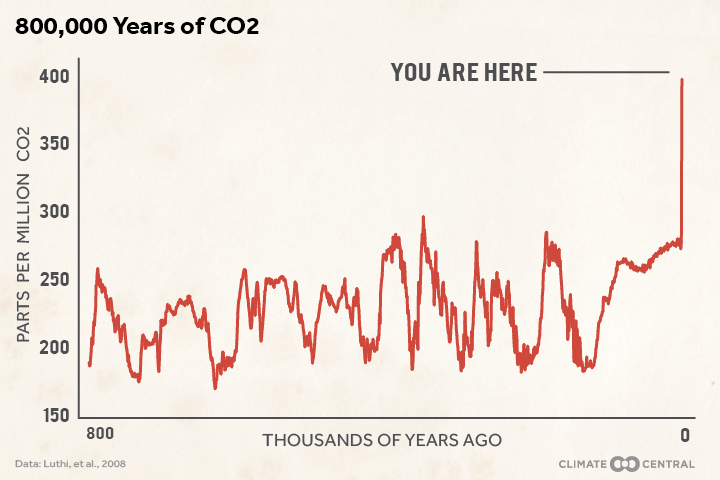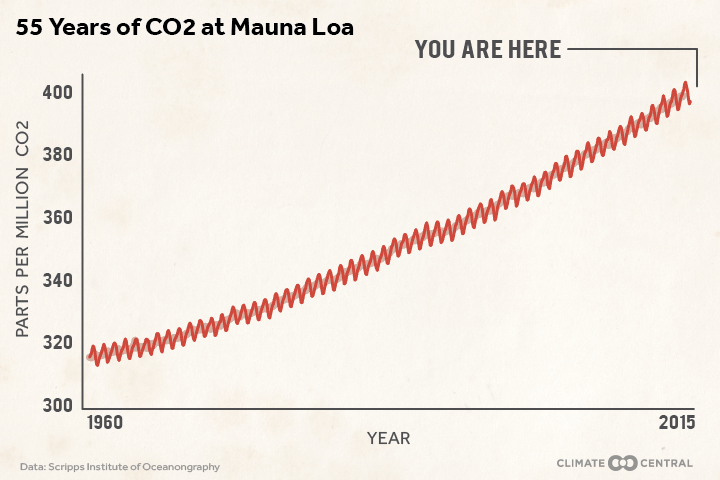News•November 20, 2015
What Passing a Key CO2 Mark Means to Climate Scientists
By Andrea Thompson and Brian Kahn
This week is a big one for our world. Atmospheric carbon dioxide (CO2) levels climbed above the 400 parts per million (ppm) at the Mauna Loa Observatory and it’s distinctly possible they won’t be back below that level again in our lifetimes.
Humans have burned enough fossil fuels to drive atmospheric CO2 to levels that world hasn’t seen in at least 400,000 years. That’s driven up temperatures, melted ice and caused oceans to acidify. Some extreme weather events around the world have become more likely and stronger because of it, and some will likely only get worse as the planet continues to warm.

Because CO2 sits in the atmosphere long after it’s burned, that means we’ve likely lived our last week in a sub-400 ppm world. It also means that the reshaping of our planet will continue for decades and centuries to come, even if climate talks in Paris in two weeks are successful.
To get some perspective on what this means for the world, we asked leading climate scientists for their insight on passing this milestone as well as what it means for their particular areas of research. Below are their answers, some edited lightly for clarity or length.
How Do You Feel About CO2 Levels Passing This Threshold?
Ralph Keeling, director of the Scripps CO2 Program: “It will take some getting used to psychologically, like a round-numbered birthday. For someone who remembers when CO2 was only around 330 ppm, it's a pretty big change.”
Jason Box, ice researcher at the Geologic Survey of Denmark and Greenland: “I feel very concerned because the last time atmospheric CO2 was this high, global sea levels were at least six meters higher. You can see a recent study by Andrea Dutton and others on sea level rise due to polar ice-sheet mass loss during past warm periods.”
Michael Mann, climatologist at Penn State University: “Well, it is a sad milestone. CO2 levels were about 320 ppm when I was born in 1965. It is shocking to realize that they’ve gone up 80 ppm over the course of my lifetime.”
Katharine Hayhoe, atmospheric scientist at Texas Tech University: “As a scientist, the difference between 399 ppm vs. 401 ppm is negligible.
As a human, though, passing both the 400 ppm and (potentially) the 1°C threshold within such a short time period makes it clear we are already living in a different world. We have blown past targets that were being considered as viable when I entered graduate school. We have significantly reduced the options available to us in the future. If we aren’t going to blow past the next set of thresholds — 500 ppm and 2°C — within just a few more decades, we have a lot of work to do in Paris in two weeks and beyond.”
Peter Gleick, president of the Pacific Institute: “In some ways, the number 400 ppm is no different than 395 ppm or 390 ppm — it is just that we like watching our odometers turn over at even numbers with lots of zeros. But this feels far more important than pure symbolism. The truth is, when I was born, atmospheric CO2 levels were around 300 ppm. Today — maybe even this week — will be the last time anyone alive experiences a level below 400 ppm, and no one born in the coming century or even longer will ever see less than 400 ppm again. That is a deep, deep observation, with ramifications for our children and for every future generation.”
Pieter Tans, head of the Carbon Cycle Greenhouse Gases Group at the Environmental System Research Laboratory: “What do I feel about this? Awe! To me, it demonstrates the continuing and unavoidable rise of CO2 as long as mankind continues to burn coal, oil, and natural gas in quantities so large that natural systems are being overwhelmed.”
Atmospheric CO2 concentrations in early spring, when plants in the northern hemisphere are still dormant, vs. summer, when plants draw CO2 out of the atmosphere.
Credit: NASA
What Does Reaching This Level Mean For Your Area Of Climate Science?
Ralph Keeling: “400 ppm is not a magic number for climate, but it does nicely symbolize that we are now in a new era of Earth history, a point that climate scientists have been making already for a while.”
Michael Mann: “It means that we are still trending at the upper end of past CO2 projections. It underscores the importance of acting now if we are going to avert dangerous interference with our climate. I suppose it stresses the importance of making substantial progress toward a meaningful international climate treaty at the Paris Summit later this month.”
Peter Gleick: “My focus is on the risks to our water resources from climate change. Some of the most significant impacts of future climatic changes, and some of the most obvious changes we've already seen, are on water resources, from a growing influence of climate change on extreme hydrologic events such as both floods and droughts, to a connection with social unrest and violence. I wrote a paper, for example, on the links between drought, climate change, water management, and the conflict in Syria published in the journal Weather, Climate, and Society. Here is a link.”
John Church, sea level rise researcher at the University of Tasmania: “The oceans, glaciers and ice sheets are all out of balance so sea level will rise for centuries, and more.”

Do You Think This Milestone Will Spur Action On Climate Change?
Ralph Keeling: “For those who are paying attention, it may further motivate. For those who haven't been paying attention, perhaps it's a starting point for understanding that changes is underway. ‘Remember, back when CO2 was only 400 ppm?’ ”
Jason Box: There's lots of talk about needed emissions reductions but emissions reductions won't get us down below 350 ppm where we need to be to avoid climate chaos. The missing conversation is how are we going to get CO2 down below 350 ppm? Fortunately the answer is in an amazing overlooked and existing technology (AOET ;-)): the tree. So here, I made some calculations what it would take.
Katharine Hayhoe: “Passing such a milestone can just as easily create a sense of despair as it can urgency. Which will win out? I don’t know — but I hope it’s the latter.”
Peter Gleick: “Yes, I do. While any particular measurement of atmospheric CO2 is an arbitrary number (e.g., 390 ppm, 398 ppm), round numbers mark milestones that help focus our attention and awareness. Combined with a growing number of increasingly severe weather events, improved science connecting the influence of climate change to extreme events, and milestones like 400 ppm CO2, pressure is finally building to tackle climate change. We'll see if the world finally acts and whether those actions will be enough to prevent ever accelerating and severe impacts to the planet and humans.”
Pieter Tans: “I think that most policy makers are already convinced that substantive action is needed. What is missing is the pressure to follow through as long as the public lets them get away with doing nothing by not demanding action strongly enough. The 400 ppm milestone is an opportunity for public education.”
John Church: “Not as urgently as required.”
Julienne Stroeve, research scientist at the National Snow and Ice Data Center: “Doubtful. Any action on climate change will be driven by economics; sadly that's the way the world currently works. Unless it's economically viable to reduce CO2 emissions and turn to renewables, it will not happen unless there is money to make.”
Eric Rignot, Antarctic expert at NASA Jet Propulsion Laboratory: “No. 400 ppm does not speak to anyone.”
An animation showing how carbon dioxide moves around the planet.
Credit: NASA/YouTube
You May Also Like:
Forecasters Say U.S. Faces an El Niño-Dominated Winter
The Forgotten U.N. Climate Goal: 1.5°C
U.K. Plans to Shutter All Coal-Fired Power Plants by 2025
U.S. Agencies Agree: October Was Crazy Warm
